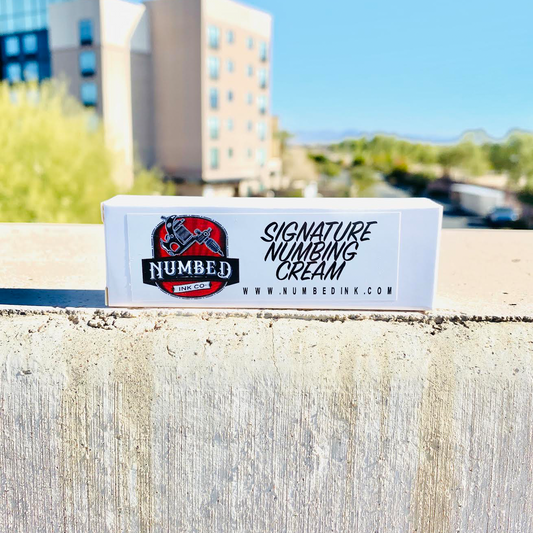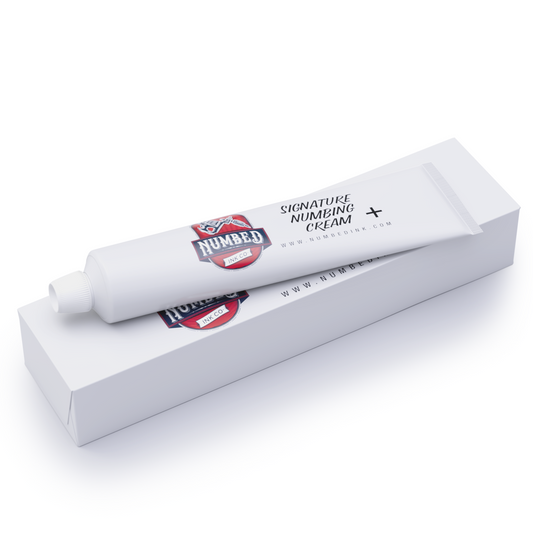How do you take care of a thigh tattoo?
Your new tattoo looks great, now it’s time to keep it that way. Tattoo aftercare follows a few main principles – care for the wound (clean & moisturize), avoid sources of bacteria (swimming, sunlight, dirty jewelry, etc.), and monitor for signs of infection.
But for thigh tattoos, there’s a few extra things to consider to properly heal & maintain your ink.
How to clean
Just as with any new ink, cleaning your thigh tattoo is one of the most important aspects of aftercare. Fortunately, it’s pretty straightforward.
Wash your hands with warm water & soap for at least 20-30 seconds before touching the area. Then, use a fragrance-free, antibacterial liquid soap to clean the ink directly with your fingers & hand. Do so at least 3x per day – in the morning, around lunch, and before bed.
There are plenty of options when shopping for the right soap, so it’s easy to feel overwhelmed. To make it easy, choose a fragrance-free, liquid, pump soap to prevent damage and avoid irritations & infections.
Avoid using any moisturizing soaps or exfoliating scrubs as they will irritate the skin. Similarly, bar soaps aren’t the greatest option either because they tend to sit in water after use, where it can collect bacteria.
Our top picks are Dr. Bronner Liquid Baby Soap ($8) and Dial Liquid Hand Soap ($2), both of which are available almost everywhere.
Once you’ve cleaned the area, gently pat your skin dry with a clean paper towel or antimicrobial cloth. Unless it’s clean, avoid using a cotton hand towel to dry the area as it may harbor germs & other bacteria.
How to moisturize
What to apply
Similar to the soap, you should use a scent-free or fragrance-free, white cream lotion or moisturizer to hydrate the skin cells and encourage healing.
Or if you’re looking for a do-it-all aftercare product for your thigh tattoo, check out Ink Balm. Apply it directly to the area 1-2x daily instead of lotion to protect and preserve your ink.
It relieves pain & itchiness, prevents infections, moisturizes, and keeps your ink looking vibrant forever.
Why moisturizing is important
Moisturizing is an important part of the healing process. It helps your skin regenerate more quickly, reduce irritation, and create the overall best environment for your skin cells to heal the damaged skin.
Though you may have heard that it’s best to let wounds “dry out,” that could not be more wrong when it comes to tattoos.
Dry skin reduces cellular activity and delays the healing process. And, dry skin is more susceptible to bacterial infections, which will ruin your tattoo.
When to moisturize
Apply your daily tattoo moisturizer as soon as the area begins to dry out, usually within 24 hours of your session.
If you’re using lotion to moisturize, apply 3-5x per day for at least the first two weeks, then regularly as a part of your daily skincare regimen.
With Ink Balm, apply just once or twice daily for optimal moisture, skin health, and ink vibrance.
With daily cleaning and moisturizing, your skin & ink will heal in no time. But, aftercare is easier said than done when factoring in your daily routine. Fortunately, we’ve got you covered.
How thigh tattoos affect your daily routine
How do you sleep with a new tattoo on your thigh?
For the first night, keep your wrapping that your artist placed on to protect your fresh wound and enable it to begin the healing process.
For the next 2-3 nights, cover it with a fresh wrap. And after those first few nights, you’ll be able to sleep a bit more comfortably without a wrap.
Assuming only one of your thighs is inked, sleep on the opposite side of your body to allow the area more room & reduce the friction while moving around at night.
Similarly, if your tattoo is on the front of your thigh, sleep on your back. And if it’s on the back of your thigh, sleep on your stomach or side.
If you tend to toss & turn at night, or have restless leg syndrome, place some extra pillows around your body to limit movement.
For clothing, wear loose-fitting shorts or underwear to avoid causing friction or trapping heat.
And even though your tattoo will be covered for the first few nights, it’s important to limit the amount of germs in your bed. Clean your sheets, leave your pets off the bed, and keep the room at a cool temperature.
And lastly, sleep is so important to the healing process – so be sure to get your 6-8 hours each night to maximize healing.
Can I wear jeans or leggings after a thigh tattoo?
No, you should avoid wearing jeans, leggings, tights, or other pants after getting a thigh tattoo. Tight-fitting pants trap heat and increase friction, which will damage your tattoo.
If your piece extends into your waistband, lower, or middle back area, avoid wearing any clothes with a tight or restrictive waistband for the same reasons.
Can do you workout after a thigh tattoo?
Wait at least 1-2 days before working out, especially high-intensity training. Heavy sweating may cause infections and even distort the appearance of your new piece, blurring or fading the ink.. After that initial period, you can slowly resume low-intensity lower body workouts such as walking.
If you’re really looking to get a solid workout in, wait at least 1-2 weeks before doing so, and try to focus on upper body movements to reduce the strain on your thighs. And definitely skip the sauna afterwards.
When hitting the gym, wear loose fitting, flowy shorts to allow your legs to breathe freely. And if possible, try to loosen the waistband as much as possible to reduce friction while moving around.
It’s no secret that gyms are full of germs & potential infections. So be sure to shower, clean, and moisturize the area as soon as you get home.
Note: Major weight changes may affect the look & healing process of your tattoo. Usually, these changes are only noticeable with changes of 100+ pounds.
Can you drive after a thigh tattoo?
Depending on the size & location of your tattoo, you might be able to drive. If it’s a large piece on the back of your leg, it’s best to have someone pick you up so that you can elevate the area off of the car seat to avoid irritating the new ink.
If it’s on the top or side of your leg, you should be fine to drive so long as your seatbelt doesn’t rub against it.
Or if you live close to your tattoo shop, a short 5-10 minute walk might be an option, assuming you applied tattoo numbing cream before your session. But if you feel unwell to walk or drive, do not attempt to do so. Ask a friend, use public transportation, or call for a rideshare to safely take you home.
Don’t itch
This is easier said than done. Though you might want to scratch or itch your skin to relieve subtle irritation, you should avoid doing so – it will only damage the ink and cause further irritation.
If you’re constantly fighting the urge to itch the tattoo, apply moisturizer to the dry skin to get rid of the sensation.
Stay out of the water
You must avoid pools, lakes, and oceans for the first few weeks after your tattoo. Even with chlorine, these bodies of water are not sterile and will likely cause infection, ruining your ink forever.
Aside from infection, chlorine and other pool chemicals can negatively affect the color, vibrance, and overall cosmetic appearance of your new tattoo.
If you want to spend a day at the pool or the beach, keep your leg out of the water and cover the area with a waterproof bandage just in case.
If you accidentally get your ink wet, clean the area immediately to prevent infection.
What about showering?
You should continue to shower daily, especially after getting a new thigh tattoo. In addition to basic hygiene, it will help keep the area clean and prevent infections. Shower with cool water and avoid using a loofah or washcloth to clean the area as the added friction will irritate the skin, delaying the healing process. And don't forget to use a tattoo-friendly soap.
Stay out of the sun
Even a few minutes of UV exposure can fade, crack, and/or blister your tattoo, so be sure to cover your tattoo with plenty of sunscreen.
You should try to avoid the sun for 3-4 weeks after your session, but we know that’s not always possible (or fun). To protect your ink from UV exposure, use a broad-spectrum, fragrance-free sunscreen that is at least 30-50 SPF. Oftentimes, sunscreens are made from artificial ingredients that can irritate the skin, so choose a mineral sunscreen that's made from organic ingredients.
If you’re having trouble finding a suitable option for your skin, those made from zinc oxide or titanium oxide are both recognized as non-toxic ingredients by the FDA.
Factors that affect the healing process
Even if you follow the perfect aftercare routine, there are factors that can affect the healing process.
Size
It’s no secret that larger tattoos take longer to heal, especially those that require you to sit for long hours or even multiple sessions.
There’s more skin to tend to, meaning more room for infections, friction, and other exposure.
Location
Back of Thigh
These are often the trickiest to heal because if you are constantly sitting, the skin can’t breathe properly. As well, if you normally sleep on your back, you’ll have to adjust for a few weeks while the skin heals.
Upper/Front Thigh
Upper thigh tattoos are very popular recently. Because you aren’t constantly worried about sitting on it and you can see it when you look down, these are generally easier to maintain.
Outer Thigh
Outer thigh tattoos generally sit higher on your hip, closer to your waistband. For this reason, it can be difficult to avoid rubbing your skin against the waistband of your clothing.
How long does a thigh tattoo take to heal?
With a proper aftercare routine, the top layer of skin on your thigh tattoo should heal within 2-4 weeks. The exact amount of time depends on the size & location of the piece, as well as your own skin sensitivity and commitment to the healing process. This is the standard timeline, which can be delayed by things like infections, sun exposure, and constant itching.
Because the ink penetrates so deeply though, your skin may take upwards of six months to fully heal.



